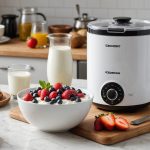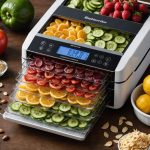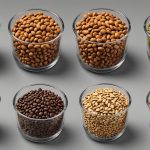Understanding Food Dehydration
Dehydration is a method of preserving food by removing its moisture content, which inhibits the growth of spoilage-causing microorganisms. This technique dates back centuries and continues to be popular due to its simplicity and effectiveness. By reducing moisture, dehydration helps retain the original nutrients of the food, ensuring that vitamins and minerals remain intact. This is vital for individuals looking to maintain a nutrient-rich diet over longer storage periods.
One of the most significant benefits of food dehydration is nutrient preservation. Unlike other preservation methods such as canning or freezing, dehydration doesn’t subject food to extreme temperatures or additional chemicals, minimising nutrient loss. As a result, dehydrated foods often retain a high level of vitamins, minerals, and enzymes.
Additional reading : Unlocking blender selection secrets: effortlessly choose the ideal model for crushing nuts and seeds
Additionally, food dehydration offers a surprising advantage in flavor enhancement. Concentrating the food by removing its water can intensify its natural flavours, leading to richer and more robust tastes. Foods like tomatoes, fruits, and meats can develop deeper, more complex flavours when dried. Moreover, this technique allows culinary enthusiasts to experiment with various flavour infusions and seasonings, opening a world of creative and delicious possibilities. Dehydration thus preserves not only the nutritional quality but also elevates the sensory experience of the food.
Key Features of Food Dehydrators
Understanding the key features of food dehydrators can greatly impact your experience and results. One crucial element to consider is temperature control. Adjustable temperature settings are important as different foods require specific drying temperatures to retain nutrients and achieve the best texture. For instance, herbs usually need lower temperatures compared to meats, which require higher settings to ensure complete drying.
Topic to read : The ultimate handbook for choosing a reliable and multifunctional mandoline slicer
Another critical feature is airflow. Effective dehydration relies on consistent airflow to evenly distribute heat and remove moisture from the food. An optimal airflow system prevents uneven drying, which can lead to spoilage or undesirable textures. Considering whether a dehydrator offers horizontal or vertical airflow can help in making a well-informed decision.
Food dehydrators come in two main types: tray-based and stackable models. Tray-based dehydrators typically offer better airflow distribution and are ideal for bulk drying. Stackable dehydrators, on the other hand, offer flexibility in adjusting the number of trays based on the amount of food. Understanding these differences can guide you in selecting the most suitable dehydrator for your needs, ensuring you make the most of your food dehydration efforts.
Top Food Dehydrator Recommendations
Selecting the right food dehydrator can enhance your dehydration experience significantly. Here’s a breakdown of the best food dehydrators along with insights from expert reviews and product comparisons.
High-End Models
When it comes to top-tier performance, high-end models often deliver exceptional durability and efficiency. These models typically feature advanced temperature control and superior airflow systems, ensuring even drying and nutrient preservation. Brands like Excalibur and Sedona are renowned for their reliability and user-friendly interfaces, providing consistent results.
Mid-Range Options
For those seeking a balance between quality and affordability, mid-range dehydrators offer robust features without breaking the bank. They often include adjustable temperature settings and efficient design without the premium price tag. Consider models from Nesco and Hamilton Beach which have received positive customer feedback for their performance and adaptability.
Budget-Friendly Picks
Budget-friendly dehydrators are perfect for beginners or those with occasional drying needs. Despite their lower price, brands such as Presto and Chefman provide decent functionality, including basic temperature adjustments. These models are often compact and simple, offering value for money while allowing users to explore food dehydration with ease.
Choosing the right dehydrator requires careful consideration of your needs, budget, and the features most important to you.
Techniques for Preserving Nutrients During Dehydration
In food dehydration, employing effective nutrient preservation techniques is crucial for maintaining the food’s quality. One key practice is pre-treatment methods like blanching, soaking, and seasoning. These techniques prepare the food for drying by reducing enzyme activity, which can otherwise lead to nutrient degradation. Blanching, for instance, involves immersing food briefly in boiling water to enhance preservation when dehydrated.
Slicing techniques also play a significant role in even drying. Uniform slicing allows heat and air to evenly reach all parts, ensuring that nutrients are conserved throughout the dehydration process. This step is especially important for dense foods where nutrient preservation might otherwise be compromised if not uniformly dehydrated.
Once foods are properly dried, storing dehydrated foods in airtight containers protects their nutritional quality. Exposure to air, light, and moisture can lead to nutrient loss over time, hence keeping them sealed is vital.
By mastering these practices, you can ensure maximum nutrient retention while still benefiting from the longevity and convenience that dehydration offers. Such meticulous attention to preparation and storage underscores the practical importance in maintaining nutrient levels during the dehydration process, making it a more reliable preservation method.
Flavor Enhancement Methods
Food dehydration opens exciting possibilities for flavor enhancement by allowing you to experiment with seasonings and infusions before the drying process. Proper seasoning is a pivotal step, as the absence of moisture can intensify flavors, making the tastes more pronounced. To achieve the best results, apply seasonings and marinades evenly to ensure consistent flavor throughout. This method is particularly effective for foods like jerky or fruit slices, where the enhanced flavor can shine through.
Incorporating herbs and spices into your dehydration practice offers a wonderful way to add complexity to your foods. These additions not only enhance the taste but also contribute health benefits. For instance, adding rosemary to dried meats or basil to tomatoes can elevate dishes into a more gourmet experience, adding a delightful twist to traditional favorites.
A creative approach to flavor infusions involves using dehydrated foods in cooking. Rehydrating vegetables and meats in homemade stocks or soups imbues dishes with concentrated flavors. A prime example includes infusing water with dehydrated citrus slices for refreshing beverages or using dried herbs to craft aromatic broths. With these techniques, dehydrated foods transcend simple preservation, transforming into versatile ingredients that bring depth and richness to culinary creations.
Pricing and Product Comparisons
Understanding food dehydrator prices and comparing features can guide buyers toward the best value for their needs. Dehydrators are available across a spectrum of price ranges, from budget-friendly under £50 to high-end models exceeding £250. While lower-range models may offer the basic functions, high-end options usually include advanced controls and robust design, essential for enthusiasts seeking superior performance.
Comparing features versus cost among different models can be insightful. For example, a mid-range dehydrator might offer adjustable temperature control and reliable airflow, balancing price with necessary functions for effective drying. This consideration is crucial as it enables users to align their budget with essential features, ensuring value for money in their purchase.
Analysing user ratings also offers a layer of practicality. Highly rated dehydrators often reflect consistent quality and satisfaction. Users often highlight their experiences with temperature consistency and ease of use, providing real-world insights into performance.
In conclusion, selecting the ideal dehydrator involves weighing the cost against features and user experiences. By examining these elements, consumers can make informed choices that harmonise budgetary constraints with functional expectations.
Practical Usage Tips
Mastering the use of a food dehydrator can maximize both nutrient preservation and flavor enhancement. A key aspect is the strategic loading and arrangement of food in the dehydrator. Proper spacing is crucial for optimal airflow and even drying, preventing spoilage and promoting uniform nutrient retention. Line up similar sizes together to ensure consistent results.
Monitoring progress is another essential step. Periodically checking the drying status allows for precise control over the desired texture and flavor intensity. Some foods might require adjustments to drying times, making flexibility an asset for achieving perfection in your batches.
When it comes to maintaining your equipment, cleaning and maintenance are paramount. Regularly cleaning trays and air systems prevents residue build-up, ensuring efficient airflow and maintaining the integrity of flavors. This prolongs the lifespan of your dehydrator and guarantees consistently pleasant results in food dehydration endeavors.
By adhering to these practical tips, users can confidently utilize their dehydrators to achieve precise drying, enhancing both the nutritional and culinary value of their foods. These guidelines ensure that the process remains efficient, straightforward, and rewarding, making dehydration a simple yet effective technique for preserving and enhancing foods.
Recipes Using Dehydrated Foods
Integrating dehydrated foods into daily cooking can elevate both flavour and convenience. These versatile ingredients are perfect for creating nutritious and flavourful dishes. Let’s delve into some creative culinary uses.
Snacks and Trail Mixes
Dehydrated snacks are a simple yet delicious option. You can effortlessly prepare homemade trail mixes by incorporating dehydrated fruits and nuts. The concentrated flavours of dehydrated bananas, apples, or berries offer a natural sweetness that pairs well with salty nuts. This combination provides a healthy, energy-boosting snack, ideal for on-the-go or post-exercise refuelling.
Incorporating into Main Dishes
Enhance main dishes by rehydrating foods like dried tomatoes or mushrooms. This process involves soaking the foods briefly in water or broth. These ingredients can be added to sauces, stews, or pizzas, delivering rich, intensified flavours to your meals. For instance, rehydrated tomatoes shine in pasta dishes, bringing a robust taste profile that stands out.
Dehydrated Vegetable Broths
Creating broths with dehydrated vegetables saves time while maintaining flavour and nutrients. Simply rehydrate vegetables in hot water to produce a hearty base for soups and stews. This method not only enhances the dish’s depth of flavour but also allows for customization in terms of seasoning and flavour intensity. Embrace dehydrated foods for innovative, savoury results.
User Reviews and Testimonials
In recent years, user reviews have become pivotal in guiding consumer choices, particularly in the realm of food dehydrators. Users often voice common themes in their experiences, emphasizing the ease of use and effective drying capabilities of high-rated models. Notably, many consumers appreciate models that offer adjustable temperature control, allowing for precise dehydration across various food types.
Pros often highlighted include intuitive interfaces and consistent performance, making food dehydration an effortless task. Customers regularly commend best food dehydrators that ensure even drying, praising brands such as Excalibur and Nesco for their reliable airflow systems. Enhanced nutrient preservation techniques are frequently acknowledged, with users noting the superior retention of flavour and nutrition compared to other preservation methods.
Conversely, some cons include noise levels during operation or the size of the devices if kitchen space is limited. Consumers’ insights into cleanup processes reveal a preference for models with removable trays, which facilitate easier maintenance.
Brands like Hamilton Beach and Presto often emerge in testimonials for their blend of functionality and affordability, suggesting a wide appeal across different consumer preferences. Engaging with this feedback allows potential buyers to weigh the advantages and drawbacks effectively, ensuring informed decisions in their selection process.










